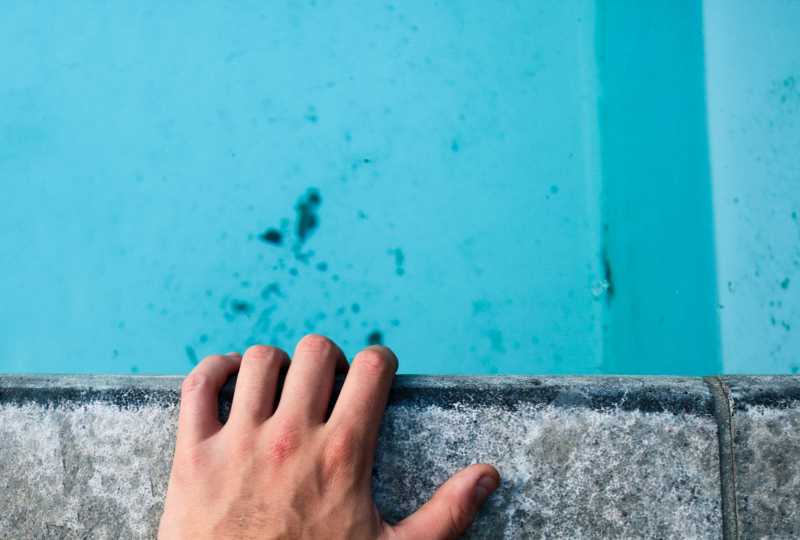
Stain and Scale Remover
Stains and scale can appear in any type of pool, including concrete, plaster, or vinyl liner pools and commonly affect the tile or pool surface. The cause and treatment for both pool stains and scale are similar.
What Causes Scale Buildup?
Scale formation occurs when calcium carbonate solidifies on pool walls and surfaces after the water has evaporated or when calcium deposits are floating in the pool. It typically indicates that a pool’s calcium levels, alkalinity, or pH are not balanced.
Scale buildup generally shows up on pool tiles first as a white film, creating the appearance of a faded tile. Eventually, a white or white-grey scale forms on the pool’s edges with a rough, gritty texture that can be hard to remove. The waterline scale can turn brown or grey if the calcium combines with dirt and oil.
There are two main types of calcium buildup: calcium carbonate and calcium silicate. Calcium carbonate is white and flaky, and easier to remove. The white-grey-coloured calcium silicate is more challenging to remove from pools.
To determine which type of scaling you have, see if your scaling will react with a few drops of muriatic acid. If it does, calcium carbonate is present.
What Causes Staining?
Pool stains can result from organic materials or metals.
Organic pool stains are commonly caused by natural debris such as leaves, animals, berries, algae, and mud.
Metal pool stains can result from corroding metal pipes, well water, copper algaecides, or lawn chemicals. After discolouring your water, metals will eventually stain your finish. Although they’re unsightly, metal stains will not damage your finish if left untreated.

Types Of Stain And Scale Removers
There are various stain and scale removers to choose from. Selecting the right one for your pool depends on the type of stain or scale you have.
Scale Removers
Products for Removing Calcium Carbonate Scaling
Pumice Stone
Scaling on hard surfaces such as ceramic tile, plaster, and concrete can be removed with a pumice stone, which is a natural volcanic stone.
To Use: While keeping the stone and pool surface wet to prevent scratching, scrub the deposits with the stone.
Stain Eraser
These soft abrasives can be used on any type of pool, even vinyl and fibreglass pools, and are effective at removing calcium scale at the water line or anywhere else in the pool.
To Use: Attach the stain eraser to a pool pole or a handheld pool stain scrubber, then scrub the scale or stain with the stain eraser. Follow the manufacturer’s directions for specific instructions.
Scale Remover
A calcium scaling treatment is safe for all pool surfaces and is sold at your local pool supply store.
To Use: Add the calcium scaling treatment directly to the pool water as per the manufacturer’s instructions. Over the next several weeks, the product will dissolve the calcium deposits.
Products for Removing Calcium Silicate Scaling
Pumice Stone
Using a pumice stone following the method above is the most effective way to remove calcium silicate deposits. However, this coarse stone can’t be used on vinyl or fibreglass pools. Use a calcium-scaling-specific additive in those situations or contact a pool service provider.
Stain Removers
Methods for Removing Organic Stains
In general, organic stains can be removed by completing a shock treatment, then brushing the stain thoroughly.
For more difficult organic stains, such as those caused by challenging types of algae, apply chlorine directly to the stain, then brush.
Methods for Removing Metal Stains
Metal stains are more challenging to remove from pools. After lowering your chlorine levels to 0ppm, you’ll need to apply an algaecide treatment that is not copper based and then rub Vitamin C or ascorbic acid onto the stains.
If you have a plaster pool, an alternative solution is to perform an acid wash. You’ll need to drain the pool first, then carefully use muriatic acid to strip a thin layer of plaster from the pool’s surfaces.
Stain And Scale Preventers For Pools
To prevent scale and stains in your pool, follow the steps below:
1. Maintain a clean pool and reduce the amount of organic waste by skimming, vacuuming, and scrubbing surfaces regularly. Empty skimmer baskets regularly as well.
2. Regularly test your water. Pay close attention to your Total Hardness, pH, Total Alkalinity, and chlorine levels. Water that is not balanced can cause stains and scale to form.
3. Check for the presence of metals in your water. Use a hose filter when topping your pool with fresh water.
4. Use a scale and stain treatment to remove fresh metal stains and protect equipment. Adding a sequestering agent to your monthly pool maintenance can help keep minerals and metals in solution during pH changes, high chlorine levels, or other water conditions.

